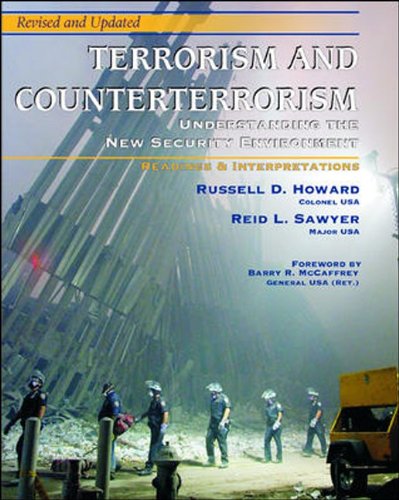In this newly revised edition of Terrorism and Counterterrorism: Understanding the New Security Environment, Colonel Russell Howard and Captain Reid Sawyer have collected original and reprinted articles and essays by political scientists, government officials, and members of the nation s armed forces. The editors and several of the authors write from practical field experience in the nation s war on terrorism. Others have had significant responsibility for planning government policy and responses. The contributors include a majority of the significant names in the field including General Barry McCaffrey, Martha Crenshaw, Bruce Hoffman, Barry Posen, Jessica Stern, Ashton Carter. Part One of the book analyzes the philosophical, political, and religious roots of terrorist activities around the world and discusses the national, regional, and global effects of historical and recent acts of terrorism. In addition to material on the threats from suicide bombers, as well as chemical, biological, radiological, and nuclear weapons, there are also important contributions analyzing new and growing threats: narco-terrorism, cyber-terrorism, genomic terrorism, and agro-terrorism. Part Two deals with past, present, and future national and international responses to--and defenses against--terrorism. Essays and articles in this section analyze and debate the practical, political, ethical, and moral questions raised by military and non-military responses (and pre-emptive actions) outside of the context of declared war. Five detailed Appendices: Chronology of Terrorism Incidents, Groups Designated as Foreign Terrorist Organizations, Terrorist Group Profiles, and Weapons of Mass Destruction.
In 1984 when I first became involved in anti-terrorism and counterterrorism efforts, most terrorism was ideological. It was part of the East versus West, Left versus Right confrontation- a small but dangerous side-show to the greater, bipolar, Cold War drama. In the past, terrorism was almost always the province of groups of militants that had the backing of states hostile to America. Under the old rules, as Brian Jenkins stated decades ago, "terrorists wanted a lot of people watching, not a lot of people dead." They did not want large body counts because they wanted converts. Today's terrorists, explains former CIA Director James Woolsey, are not particularly concerned about converts and don't want a seat at the table. "They want to destroy the table and everyone sitting at it." The events of September 11 are compelling evidence of the "new terrorism" and its tactics. Clearly, terrorists now want a lot of people watching, and a lot of people dead.
Terrorism and Counterterrorism: Understanding the New Security Environment, draws on the expertise of academics, policymakers, and those who are charged with carrying out policy to explain the "new terrorism" and its many ramifications. As the title implies, perhaps the most important feature of the book is to provide alternative ideas on how to counter the "new terrorism." Among the contributors are internationally recognized terrorism experts Martha Crenshaw, Bruce Hoffman, Magnus Ranstorp, Richard K. Betts, Barry Posen, Jessica Stern, and Ashton Carter. Reid Sawyer and I have selected new as well as previously published essays for Terrorism and Counterterrorism that analyze the roots of terrorist activity and the global effects of these acts, debate U.S. political and military options for retaliation and future protection, and apply theory to practice in an easily understood format. -Colonel Russ Howard
